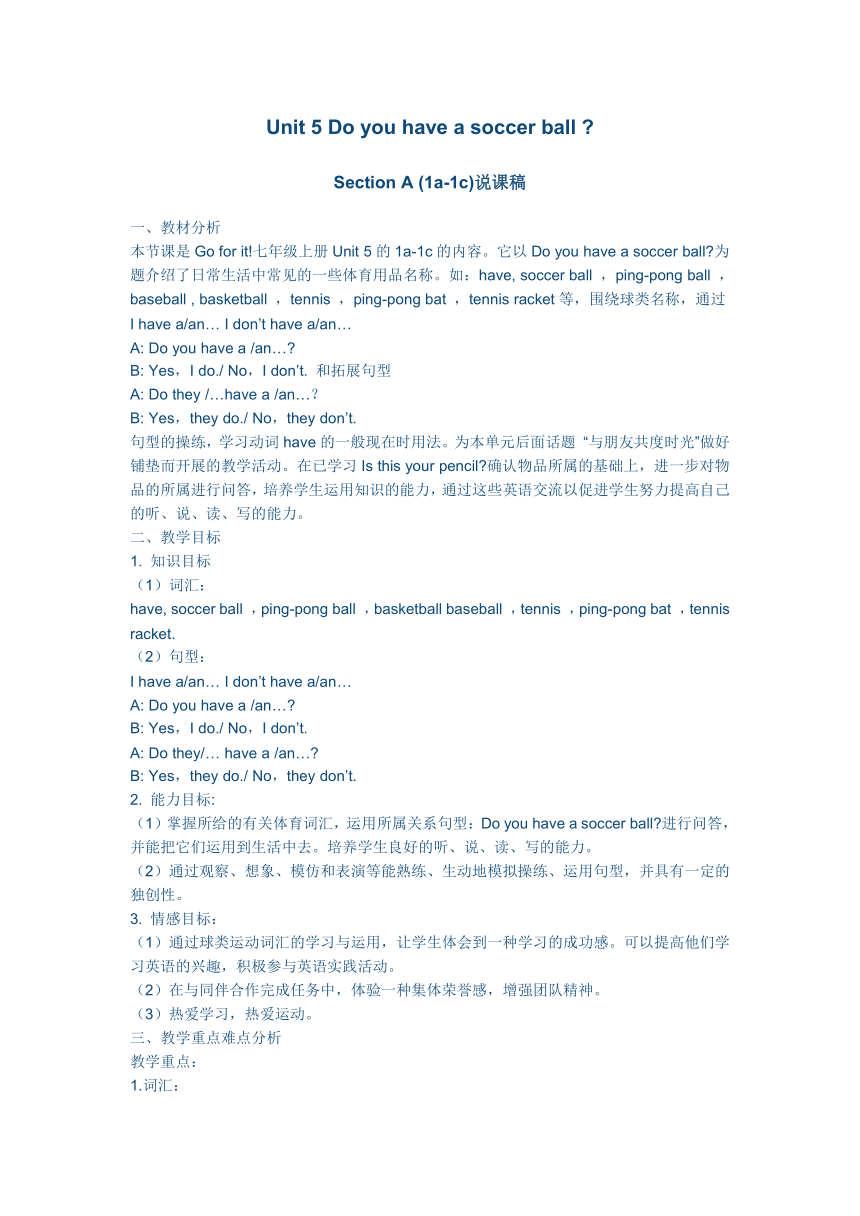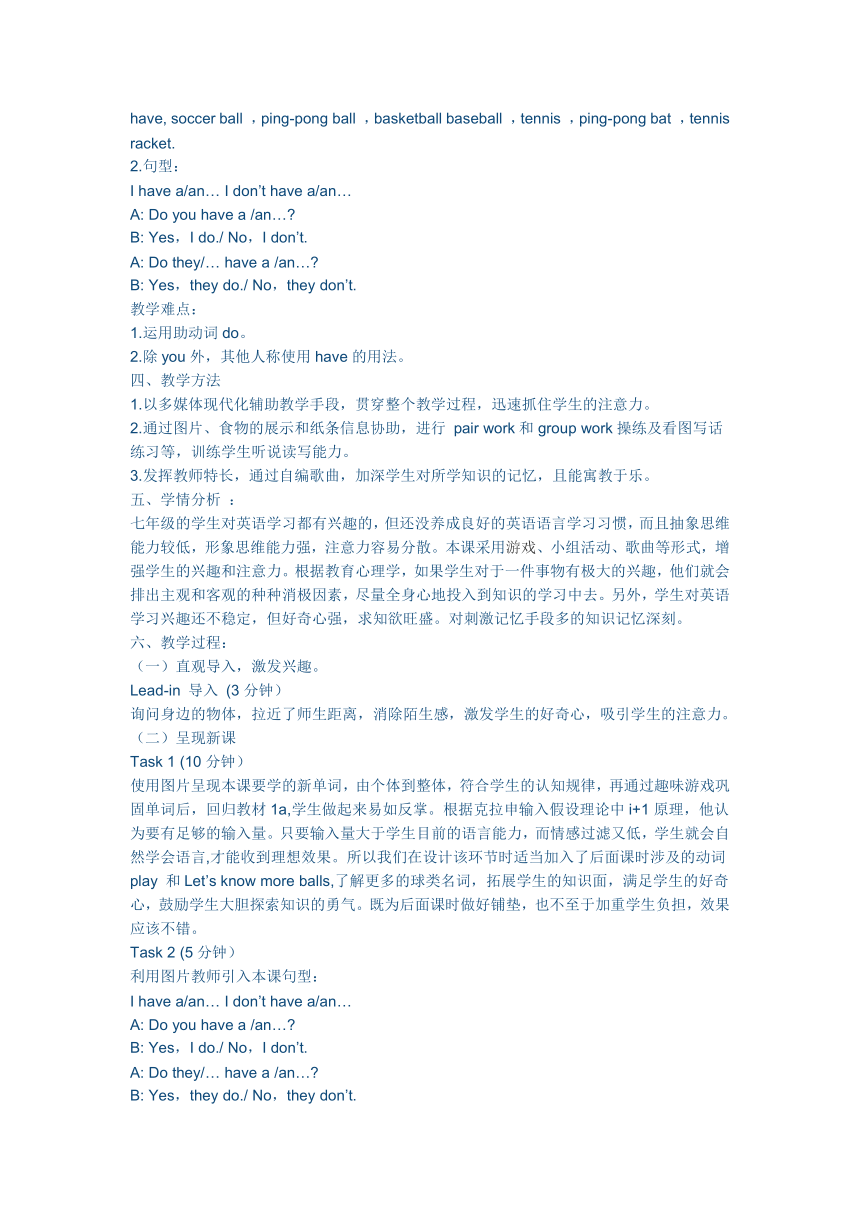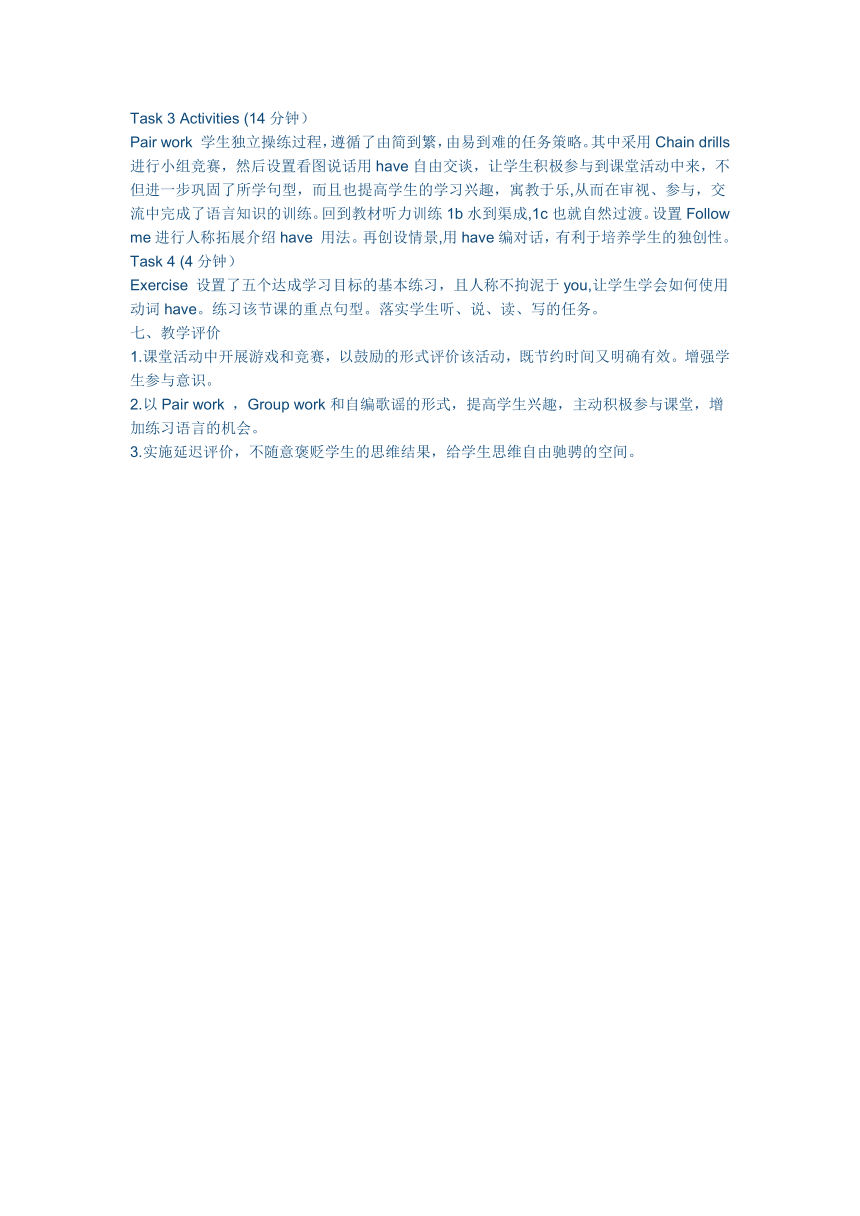人教版七年级上册Unit 5 Do you have a soccer ball?SectionA 1a-2d 说课教案
文档属性
| 名称 | 人教版七年级上册Unit 5 Do you have a soccer ball?SectionA 1a-2d 说课教案 |  | |
| 格式 | doc | ||
| 文件大小 | 46.0KB | ||
| 资源类型 | 教案 | ||
| 版本资源 | 人教新目标(Go for it)版 | ||
| 科目 | 英语 | ||
| 更新时间 | 2022-11-06 22:42:43 | ||
图片预览



文档简介
Unit 5 Do you have a soccer ball
Section A (1a-1c)说课稿
一、教材分析
本节课是Go for it!七年级上册Unit 5的1a-1c的内容。它以Do you have a soccer ball 为题介绍了日常生活中常见的一些体育用品名称。如:have, soccer ball ,ping-pong ball ,baseball , basketball ,tennis ,ping-pong bat ,tennis racket等,围绕球类名称,通过
I have a/an… I don’t have a/an…
A: Do you have a /an…
B: Yes,I do./ No,I don’t. 和拓展句型
A: Do they /…have a /an…?
B: Yes,they do./ No,they don’t.
句型的操练,学习动词have的一般现在时用法。为本单元后面话题 “与朋友共度时光”做好铺垫而开展的教学活动。在已学习Is this your pencil 确认物品所属的基础上,进一步对物品的所属进行问答,培养学生运用知识的能力,通过这些英语交流以促进学生努力提高自己的听、说、读、写的能力。
二、教学目标
1. 知识目标
(1)词汇:
have, soccer ball ,ping-pong ball ,basketball baseball ,tennis ,ping-pong bat ,tennis racket.
(2)句型:
I have a/an… I don’t have a/an…
A: Do you have a /an…
B: Yes,I do./ No,I don’t.
A: Do they/… have a /an…
B: Yes,they do./ No,they don’t.
2. 能力目标:
(1)掌握所给的有关体育词汇,运用所属关系句型:Do you have a soccer ball 进行问答,并能把它们运用到生活中去。培养学生良好的听、说、读、写的能力。
(2)通过观察、想象、模仿和表演等能熟练、生动地模拟操练、运用句型,并具有一定的独创性。
3. 情感目标:
(1)通过球类运动词汇的学习与运用,让学生体会到一种学习的成功感。可以提高他们学习英语的兴趣,积极参与英语实践活动。
(2)在与同伴合作完成任务中,体验一种集体荣誉感,增强团队精神。
(3)热爱学习,热爱运动。
三、教学重点难点分析
教学重点:
1.词汇:
have, soccer ball ,ping-pong ball ,basketball baseball ,tennis ,ping-pong bat ,tennis racket.
2.句型:
I have a/an… I don’t have a/an…
A: Do you have a /an…
B: Yes,I do./ No,I don’t.
A: Do they/… have a /an…
B: Yes,they do./ No,they don’t.
教学难点:
1.运用助动词do。
2.除you外,其他人称使用have的用法。
四、教学方法
1.以多媒体现代化辅助教学手段,贯穿整个教学过程,迅速抓住学生的注意力。
2.通过图片、食物的展示和纸条信息协助,进行 pair work和group work操练及看图写话练习等,训练学生听说读写能力。
3.发挥教师特长,通过自编歌曲,加深学生对所学知识的记忆,且能寓教于乐。
五、学情分析 :
七年级的学生对英语学习都有兴趣的,但还没养成良好的英语语言学习习惯,而且抽象思维能力较低,形象思维能力强,注意力容易分散。本课采用游戏 ( http: / / rj.5ykj.com" \t "_blank )、小组活动、歌曲等形式,增强学生的兴趣和注意力。根据教育心理学,如果学生对于一件事物有极大的兴趣,他们就会排出主观和客观的种种消极因素,尽量全身心地投入到知识的学习中去。另外,学生对英语学习兴趣还不稳定,但好奇心强,求知欲旺盛。对刺激记忆手段多的知识记忆深刻。
六、教学过程:
(一)直观导入,激发兴趣。
Lead-in 导入 (3分钟)
询问身边的物体,拉近了师生距离,消除陌生感,激发学生的好奇心,吸引学生的注意力。
(二)呈现新课
Task 1 (10分钟)
使用图片呈现本课要学的新单词,由个体到整体,符合学生的认知规律,再通过趣味游戏巩固单词后,回归教材1a,学生做起来易如反掌。根据克拉申输入假设理论中i+1原理,他认为要有足够的输入量。只要输入量大于学生目前的语言能力,而情感过滤又低,学生就会自然学会语言,才能收到理想效果。所以我们在设计该环节时适当加入了后面课时涉及的动词play 和Let’s know more balls,了解更多的球类名词,拓展学生的知识面,满足学生的好奇心,鼓励学生大胆探索知识的勇气。既为后面课时做好铺垫,也不至于加重学生负担,效果应该不错。
Task 2 (5分钟)
利用图片教师引入本课句型:
I have a/an… I don’t have a/an…
A: Do you have a /an…
B: Yes,I do./ No,I don’t.
A: Do they/… have a /an…
B: Yes,they do./ No,they don’t.
Task 3 Activities (14分钟)
Pair work 学生独立操练过程,遵循了由简到繁,由易到难的任务策略。其中采用Chain drills进行小组竞赛,然后设置看图说话用have自由交谈,让学生积极参与到课堂活动中来,不但进一步巩固了所学句型,而且也提高学生的学习兴趣,寓教于乐,从而在审视、参与,交流中完成了语言知识的训练。回到教材听力训练1b水到渠成,1c也就自然过渡。设置Follow me进行人称拓展介绍have 用法。再创设情景,用have编对话,有利于培养学生的独创性。
Task 4 (4分钟)
Exercise 设置了五个达成学习目标的基本练习,且人称不拘泥于you,让学生学会如何使用动词have。练习该节课的重点句型。落实学生听、说、读、写的任务。
七、教学评价
1.课堂活动中开展游戏和竞赛,以鼓励的形式评价该活动,既节约时间又明确有效。增强学生参与意识。
2.以Pair work ,Group work和自编歌谣的形式,提高学生兴趣,主动积极参与课堂,增加练习语言的机会。
3.实施延迟评价,不随意褒贬学生的思维结果,给学生思维自由驰骋的空间。
教学设计
Step One:Learn the new words.
1. Present the key vocabulary.
(Show a basketball to the class.)
T: What’s this in English
S1: It’s a basketball.
T: Yes,you are right. Read after me. B-A-S-K-E-T-A-B-L-L,basketball.
Ss: B-A-S-K-E-T-A-B-L-L,basketball.
(Show the students other objects. Teach the new words “tennis racket,ping-pong ball,volleyball,basketball” in the same way. And then show students the picture of television and teach it.)
T: Read the words together twice.
Ss: …
T: Ask and answer in pairs with these things. Use the drill “What’s this in English ” and “Where is the.. ”
2. Look at the words in 1a and match the words with the things in the picture.
T: Number 1 is (c ) ,tennis racket. What’s Number 2 Match them.
3. Ask one student to show the answers and check them.
Step Tw Present the structures.
1. Present these questions and answers.
(Point to a student who has a pen or a pencil case.)
T: Do you have a pencil case
S1:Yes, I do. (Nod your head yes)
T: Do you have a computer game
S1: No, I don’t. (Shake your head no)
2. Practice the drill “Do you have a … ” in pairs. You can use your school things and these balls.Look at the model, then practice like this.
Model:
Sa: Do you have a backpack
Sb: Yes, I do. Do you have a soccer ball
Sa: No, I don’t. I have a volleyball.
(Students work in pairs.)
Step Three: Listening practice.
T: Look at the four items of 1b in the pictures. Listen to the conversation.
(Play the recording of 1b the first time.Students only listen.)
T: Listen to the conversation and circle the words you hear.
(Play the recording again.)
T: Check their answers.
S:…
Step Four: Practice the conversations.
1. Read the conversations in 1c.
(Ask students to repeat.)
2. Look at the picture in 1a and practice the conversation with each other in pairs.
S1:Do you have…
S2:Yes, I do.
S1:Do you have a …
S2:No, I don’t.
3. Work in groups of four and use the picture to practice the similar conversations with the new words.(television,basketball, baseball bat, soccer ball, volleyball,television)
T:Ask and answer the questions as many as you can.
S1:Do you have a …
S2: …
S1: …
S2: …
Step Five: Task.
问题探究(Problem solving)
do的用法。
1.它可用作助动词,帮助构成否定句或疑问句,无实在意义。
—Do you have a sister 你有妹妹吗?
—No,I don’t.不,我没有。
2.否定句
I don’t have a ping-pong ball.
3.一般疑问句
Do you have a soccer ball
Yes, I do./No, I don’t ……….
Practice :Do you have a … Yes, I do./ No, I don’t.
What balls do you have
I have a …
Example:
S1: Do you have a tennis racket, Tom
S2: No, I don’t.
S1: What balls do you have
S2: I have basketball and football.
S1: What about you
S3: …
Summary
本节课有两要点,单词短语是重点;
语法句型要理解,一般问句是难点。
一般问句怎么变,do或does句首添;
Do或does怎么用,记住口诀很关键。
人称单三does必,其他人称do联系;
添加does要注意,后跟动原勿忘记。
热爱运动常锻炼,劳逸结合好习惯;
听说读写天天练,学好英语也不难。
Section A (1a-1c)说课稿
一、教材分析
本节课是Go for it!七年级上册Unit 5的1a-1c的内容。它以Do you have a soccer ball 为题介绍了日常生活中常见的一些体育用品名称。如:have, soccer ball ,ping-pong ball ,baseball , basketball ,tennis ,ping-pong bat ,tennis racket等,围绕球类名称,通过
I have a/an… I don’t have a/an…
A: Do you have a /an…
B: Yes,I do./ No,I don’t. 和拓展句型
A: Do they /…have a /an…?
B: Yes,they do./ No,they don’t.
句型的操练,学习动词have的一般现在时用法。为本单元后面话题 “与朋友共度时光”做好铺垫而开展的教学活动。在已学习Is this your pencil 确认物品所属的基础上,进一步对物品的所属进行问答,培养学生运用知识的能力,通过这些英语交流以促进学生努力提高自己的听、说、读、写的能力。
二、教学目标
1. 知识目标
(1)词汇:
have, soccer ball ,ping-pong ball ,basketball baseball ,tennis ,ping-pong bat ,tennis racket.
(2)句型:
I have a/an… I don’t have a/an…
A: Do you have a /an…
B: Yes,I do./ No,I don’t.
A: Do they/… have a /an…
B: Yes,they do./ No,they don’t.
2. 能力目标:
(1)掌握所给的有关体育词汇,运用所属关系句型:Do you have a soccer ball 进行问答,并能把它们运用到生活中去。培养学生良好的听、说、读、写的能力。
(2)通过观察、想象、模仿和表演等能熟练、生动地模拟操练、运用句型,并具有一定的独创性。
3. 情感目标:
(1)通过球类运动词汇的学习与运用,让学生体会到一种学习的成功感。可以提高他们学习英语的兴趣,积极参与英语实践活动。
(2)在与同伴合作完成任务中,体验一种集体荣誉感,增强团队精神。
(3)热爱学习,热爱运动。
三、教学重点难点分析
教学重点:
1.词汇:
have, soccer ball ,ping-pong ball ,basketball baseball ,tennis ,ping-pong bat ,tennis racket.
2.句型:
I have a/an… I don’t have a/an…
A: Do you have a /an…
B: Yes,I do./ No,I don’t.
A: Do they/… have a /an…
B: Yes,they do./ No,they don’t.
教学难点:
1.运用助动词do。
2.除you外,其他人称使用have的用法。
四、教学方法
1.以多媒体现代化辅助教学手段,贯穿整个教学过程,迅速抓住学生的注意力。
2.通过图片、食物的展示和纸条信息协助,进行 pair work和group work操练及看图写话练习等,训练学生听说读写能力。
3.发挥教师特长,通过自编歌曲,加深学生对所学知识的记忆,且能寓教于乐。
五、学情分析 :
七年级的学生对英语学习都有兴趣的,但还没养成良好的英语语言学习习惯,而且抽象思维能力较低,形象思维能力强,注意力容易分散。本课采用游戏 ( http: / / rj.5ykj.com" \t "_blank )、小组活动、歌曲等形式,增强学生的兴趣和注意力。根据教育心理学,如果学生对于一件事物有极大的兴趣,他们就会排出主观和客观的种种消极因素,尽量全身心地投入到知识的学习中去。另外,学生对英语学习兴趣还不稳定,但好奇心强,求知欲旺盛。对刺激记忆手段多的知识记忆深刻。
六、教学过程:
(一)直观导入,激发兴趣。
Lead-in 导入 (3分钟)
询问身边的物体,拉近了师生距离,消除陌生感,激发学生的好奇心,吸引学生的注意力。
(二)呈现新课
Task 1 (10分钟)
使用图片呈现本课要学的新单词,由个体到整体,符合学生的认知规律,再通过趣味游戏巩固单词后,回归教材1a,学生做起来易如反掌。根据克拉申输入假设理论中i+1原理,他认为要有足够的输入量。只要输入量大于学生目前的语言能力,而情感过滤又低,学生就会自然学会语言,才能收到理想效果。所以我们在设计该环节时适当加入了后面课时涉及的动词play 和Let’s know more balls,了解更多的球类名词,拓展学生的知识面,满足学生的好奇心,鼓励学生大胆探索知识的勇气。既为后面课时做好铺垫,也不至于加重学生负担,效果应该不错。
Task 2 (5分钟)
利用图片教师引入本课句型:
I have a/an… I don’t have a/an…
A: Do you have a /an…
B: Yes,I do./ No,I don’t.
A: Do they/… have a /an…
B: Yes,they do./ No,they don’t.
Task 3 Activities (14分钟)
Pair work 学生独立操练过程,遵循了由简到繁,由易到难的任务策略。其中采用Chain drills进行小组竞赛,然后设置看图说话用have自由交谈,让学生积极参与到课堂活动中来,不但进一步巩固了所学句型,而且也提高学生的学习兴趣,寓教于乐,从而在审视、参与,交流中完成了语言知识的训练。回到教材听力训练1b水到渠成,1c也就自然过渡。设置Follow me进行人称拓展介绍have 用法。再创设情景,用have编对话,有利于培养学生的独创性。
Task 4 (4分钟)
Exercise 设置了五个达成学习目标的基本练习,且人称不拘泥于you,让学生学会如何使用动词have。练习该节课的重点句型。落实学生听、说、读、写的任务。
七、教学评价
1.课堂活动中开展游戏和竞赛,以鼓励的形式评价该活动,既节约时间又明确有效。增强学生参与意识。
2.以Pair work ,Group work和自编歌谣的形式,提高学生兴趣,主动积极参与课堂,增加练习语言的机会。
3.实施延迟评价,不随意褒贬学生的思维结果,给学生思维自由驰骋的空间。
教学设计
Step One:Learn the new words.
1. Present the key vocabulary.
(Show a basketball to the class.)
T: What’s this in English
S1: It’s a basketball.
T: Yes,you are right. Read after me. B-A-S-K-E-T-A-B-L-L,basketball.
Ss: B-A-S-K-E-T-A-B-L-L,basketball.
(Show the students other objects. Teach the new words “tennis racket,ping-pong ball,volleyball,basketball” in the same way. And then show students the picture of television and teach it.)
T: Read the words together twice.
Ss: …
T: Ask and answer in pairs with these things. Use the drill “What’s this in English ” and “Where is the.. ”
2. Look at the words in 1a and match the words with the things in the picture.
T: Number 1 is (c ) ,tennis racket. What’s Number 2 Match them.
3. Ask one student to show the answers and check them.
Step Tw Present the structures.
1. Present these questions and answers.
(Point to a student who has a pen or a pencil case.)
T: Do you have a pencil case
S1:Yes, I do. (Nod your head yes)
T: Do you have a computer game
S1: No, I don’t. (Shake your head no)
2. Practice the drill “Do you have a … ” in pairs. You can use your school things and these balls.Look at the model, then practice like this.
Model:
Sa: Do you have a backpack
Sb: Yes, I do. Do you have a soccer ball
Sa: No, I don’t. I have a volleyball.
(Students work in pairs.)
Step Three: Listening practice.
T: Look at the four items of 1b in the pictures. Listen to the conversation.
(Play the recording of 1b the first time.Students only listen.)
T: Listen to the conversation and circle the words you hear.
(Play the recording again.)
T: Check their answers.
S:…
Step Four: Practice the conversations.
1. Read the conversations in 1c.
(Ask students to repeat.)
2. Look at the picture in 1a and practice the conversation with each other in pairs.
S1:Do you have…
S2:Yes, I do.
S1:Do you have a …
S2:No, I don’t.
3. Work in groups of four and use the picture to practice the similar conversations with the new words.(television,basketball, baseball bat, soccer ball, volleyball,television)
T:Ask and answer the questions as many as you can.
S1:Do you have a …
S2: …
S1: …
S2: …
Step Five: Task.
问题探究(Problem solving)
do的用法。
1.它可用作助动词,帮助构成否定句或疑问句,无实在意义。
—Do you have a sister 你有妹妹吗?
—No,I don’t.不,我没有。
2.否定句
I don’t have a ping-pong ball.
3.一般疑问句
Do you have a soccer ball
Yes, I do./No, I don’t ……….
Practice :Do you have a … Yes, I do./ No, I don’t.
What balls do you have
I have a …
Example:
S1: Do you have a tennis racket, Tom
S2: No, I don’t.
S1: What balls do you have
S2: I have basketball and football.
S1: What about you
S3: …
Summary
本节课有两要点,单词短语是重点;
语法句型要理解,一般问句是难点。
一般问句怎么变,do或does句首添;
Do或does怎么用,记住口诀很关键。
人称单三does必,其他人称do联系;
添加does要注意,后跟动原勿忘记。
热爱运动常锻炼,劳逸结合好习惯;
听说读写天天练,学好英语也不难。
同课章节目录
- starters 预备篇(2012秋审查)
- Unit 1 Good morning !
- Unit 2 What’s this in English?
- Unit 3 What color is it ?
- Unit 1 My name's Gina.
- Section A
- Section B
- Unit 2 This is my sister.
- Section A
- Section B
- Unit 3 Is this your pencil?
- Section A
- Section B
- Unit 4 Where's my schoolbag?
- Section A
- Section B
- Unit 5 Do you have a soccer ball?
- Section A
- Section B
- Unit 6 Do you like bananas?
- Section A
- Section B
- Unit 7 How much are these socks?
- Section A
- Section B
- Unit 8 When is your birthday?
- Section A
- Section B
- Unit 9 My favorite subject is science.
- Section A
- Section B
